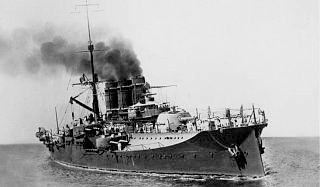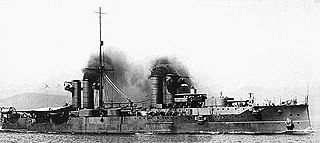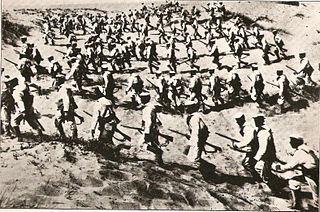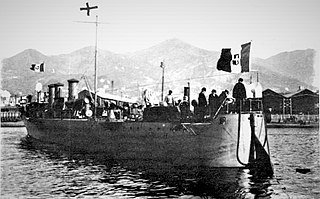
The Italo-Turkish or Turco-Italian War was fought between the Kingdom of Italy and the Ottoman Empire from 29 September 1911 to 18 October 1912. As a result of this conflict, Italy captured the Ottoman Tripolitania Vilayet, of which the main sub-provinces were Fezzan, Cyrenaica, and Tripoli itself. These territories became the colonies of Italian Tripolitania and Cyrenaica, which would later merge into Italian Libya.

Regina Margherita was the lead ship of her class of pre-dreadnought battleships built for the Italian Regia Marina between 1898 and 1904. She was armed with a main battery of four 305 mm (12 in) guns and had a top speed of 20 knots. She had one sister ship, Benedetto Brin.

Ammiraglio di Saint Bon was a pre-dreadnought battleship of the Italian Regia Marina built during the 1890s. She was laid down in July 1893, launched in April 1897, and completed in May 1901. She was the lead ship of her class, and had one sister ship, Emanuele Filiberto. The ship was armed with a main battery of four 254 mm (10 in) guns and was capable of a top speed of 18 knots.

Varese was a Giuseppe Garibaldi-class armored cruiser built for the Royal Italian Navy in the 1890s. The ship made several deployments to the Eastern Mediterranean and the Levant before the start of the Italo-Turkish War of 1911–12. She supported ground forces in the occupations of Tripoli and Homs in Libya. Varese may have bombarded Beirut and did bombard the defenses of the Dardanelles during the war. She also provided naval gunfire support for the Italian Army in Libya. During World War I, the ship's activities were limited by the threat of Austro-Hungarian submarines and Varese became a training ship in 1920. She was struck from the naval register in 1923 and subsequently scrapped.

Re Umberto was a Re Umberto-class ironclad battleship built for the Italian Regia Marina in the 1880s, the lead ship of her class. She was laid down in July 1884 and launched in October 1888; work proceeded so slowly that she was not finished until February 1893. She was armed with a main battery of four 343 mm (13.5 in) guns and had a top speed of 20.3 knots, though this high speed came at the cost of armor protection.

Vittorio Emanuele was an Italian pre-dreadnought battleship, laid down in 1901, launched in 1904 and completed in 1908. She was the second member of the Regina Elena class, which included three other vessels: Regina Elena, Napoli, and Roma. Vittorio Emmanuele was armed with a main battery of two 305 mm (12 in) guns and twelve 203 mm (8 in) guns. She was quite fast for the period, with a top speed of nearly 21 knots.

Roma was an Italian pre-dreadnought battleship, laid down in 1903, launched in 1907 and completed in 1908. She was the third member of the Regina Elena class, which included three other vessels: Regina Elena, Napoli, and Vittorio Emanuele. Roma was armed with a main battery of two 305 mm (12 in) guns and twelve 203 mm (8 in) guns. She was quite fast for the period, with a top speed of nearly 21 knots.

Napoli was a Regina Elena-class pre-dreadnought battleship built for the Italian Regia Marina in 1903–08. She was the last member of the four-ship class, which included the lead ship Regina Elena, Vittorio Emanuele, and Roma. Napoli was armed with a main battery of two 305 mm (12 in) and twelve 203 mm (8 in) guns, and was capable of a top speed of 21 knots.

The Battle of Kunfuda Bay was a naval battle of the Italo-Turkish War between small squadrons of the Italian and Ottoman navies. On 7 January 1912, the Italian protected cruiser Piemonte and the Soldato-class destroyers Artigliere and Garibaldino, cruising the Red Sea, discovered six Ottoman gunboats, a tugboat, and a yacht in the harbor at Kunfuda. The vessels engaged for over three hours and five Ottoman vessels were sunk and four dhows were captured. Three of the gunboats were damaged during the battle and grounded on the beach to prevent them from sinking. The following morning, the Italian vessels returned to destroy the remaining three vessels; the yacht, which had been sunk, was later salvaged and seized by Italy. After the battle, the Italian squadron in the Red Sea was able to proclaim a blockade of Ottoman ports in the Red Sea and frequently bombarded Ottoman positions for the rest of the war.

The Italian cruiser San Marco was a San Giorgio-class armoured cruiser built for the Royal Italian Navy in the first decade of the 20th century. She was the first large Italian ship fitted with steam turbines and the first turbine-powered ship in any navy to have four propeller shafts. The ship participated in the Italo-Turkish War of 1911–1912, during which time she supported the occupations of Benghazi and Derna, the island of Rhodes, and bombarded the fortifications defending the entrance to the Dardanelles. During World War I, San Marco's activities were limited by the threat of Austro-Hungarian submarines, although the ship did participate in the bombardment of Durazzo, Albania in late 1918. She played a minor role in the Corfu incident in 1923 and was converted into a target ship in the first half of the 1930s. San Marco was captured by the Germans when they occupied northern Italy in 1943 and was found sunk at the end of the war. The ship was broken up and scrapped in 1949.

The Battles of Zanzur or Battles of Janzur, were a series of battles that took place in 1911–1912 at Zanzur oasis, near Tripoli during the Italo-Turkish War. During the battles, the Italians unsuccessfully attacked the Turkish-Arab stronghold located approximately twelve miles from the Italian lines at Tripoli until finally achieving a victory on 20 September 1912.

The Italian cruiser Pisa was the name ship of her class of two armored cruisers built for the Royal Italian Navy in the first decade of the 20th century. The ship participated in the Italo-Turkish War of 1911–1912, during which she supported the occupations of Tobruk, Libya and several islands in the Dodecanese and bombarded the fortifications defending the entrance to the Dardanelles. During World War I, Pisa's activities were limited by the threat of Austro-Hungarian submarines, although the ship did participate in the bombardment of Durazzo, Albania in late 1918. After the war she became a training ship and was stricken from the Navy List in 1937 before being scrapped.

The Battle of Rhodes took place between Italian and German forces for the control of Rhodes, a Greek island in the Italian (1912–1943) Dodecanese islands in the Aegean Sea. The Italian authorities in Rome had been negotiating the Armistice of Cassibile with the Allies and the Germans had been manoeuvring to launch a coup in Italy and Italian-garrisoned areas in southern Europe, at the first sign of treachery to the Axis. German troops had been sent to Rhodes with tanks, artillery and air support. The British deception Operation Mincemeat intended to divert German attention from Sicily may have added to German apprehensions over the Aegean area.

The Battle of Benghazi occurred during the Italo-Turkish War when the Kingdom of Italy attacked and took possession of the major cities of the Ottoman Empire's North African Tripolitania province, now Libya. Benghazi was one of the five strategic cities captured and held by the Italians during the entire length of the war.
The Battle of Misrata was fought between Italian and Turkish forces on 9 July 1912 during the Italo-Turkish War. The battle was fought for control of the Tripolitanian town of Misrata, a major supply base for Ottoman forces.

The Battle of Tripoli was fought in October 1911, during the initial stages of the Italo-Turkish War, and saw the capture of Tripoli, capital city of Tripolitania, by Italian landing forces. It marked the beginning of the land campaign in Libya of the Italo-Turkish War as well as the beginning of the Italian colonization of Libya.
Ostro ("Ostro") was an Italian Lampo-class destroyer. Commissioned into service in the Italian Regia Marina in 1901, she served in the Italo-Turkish War and World War I. She was stricken in 1920.

Alpino was a Soldato-class ("Soldier"-class) destroyer of the Italian Regia Marina. Commissioned in 1910, she served actively in the Italo-Turkish War, operating in the Ionian, Aegean, and Red Seas. During World War I she initially operated in the upper Adriatic Sea, conducting reconnaissance and minelaying operations and supporting actions by motor torpedo boats and aircraft. She subsequently operated in the southern Adriatic and the Ionian Sea, where she was assigned to escort operations and patrolling the Otranto Barrage in the Strait of Otranto. Reclassified as a torpedo boat in 1921, she was stricken in 1928.

Artigliere was a Soldato-class ("Soldier"-class) destroyer of the Italian Regia Marina. Commissioned in 1907, she served in the Italo-Turkish War and World War I. She was stricken in 1923.
Lanciere ("Lancer") was a Soldato-class ("Soldier"-class) destroyer of the Italian Regia Marina. Commissioned in 1907, she served in the Italo-Turkish War and World War I. She was stricken in 1923.


















